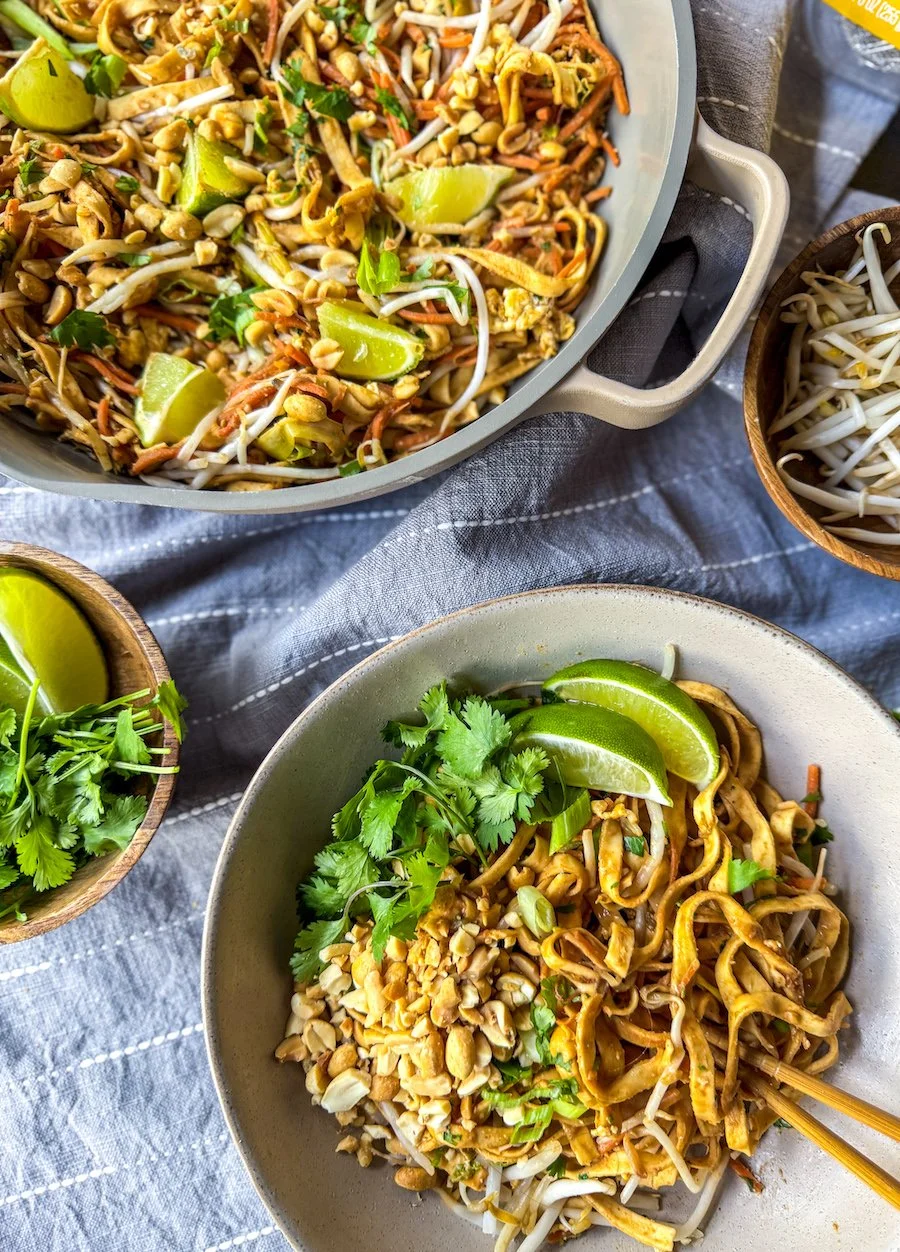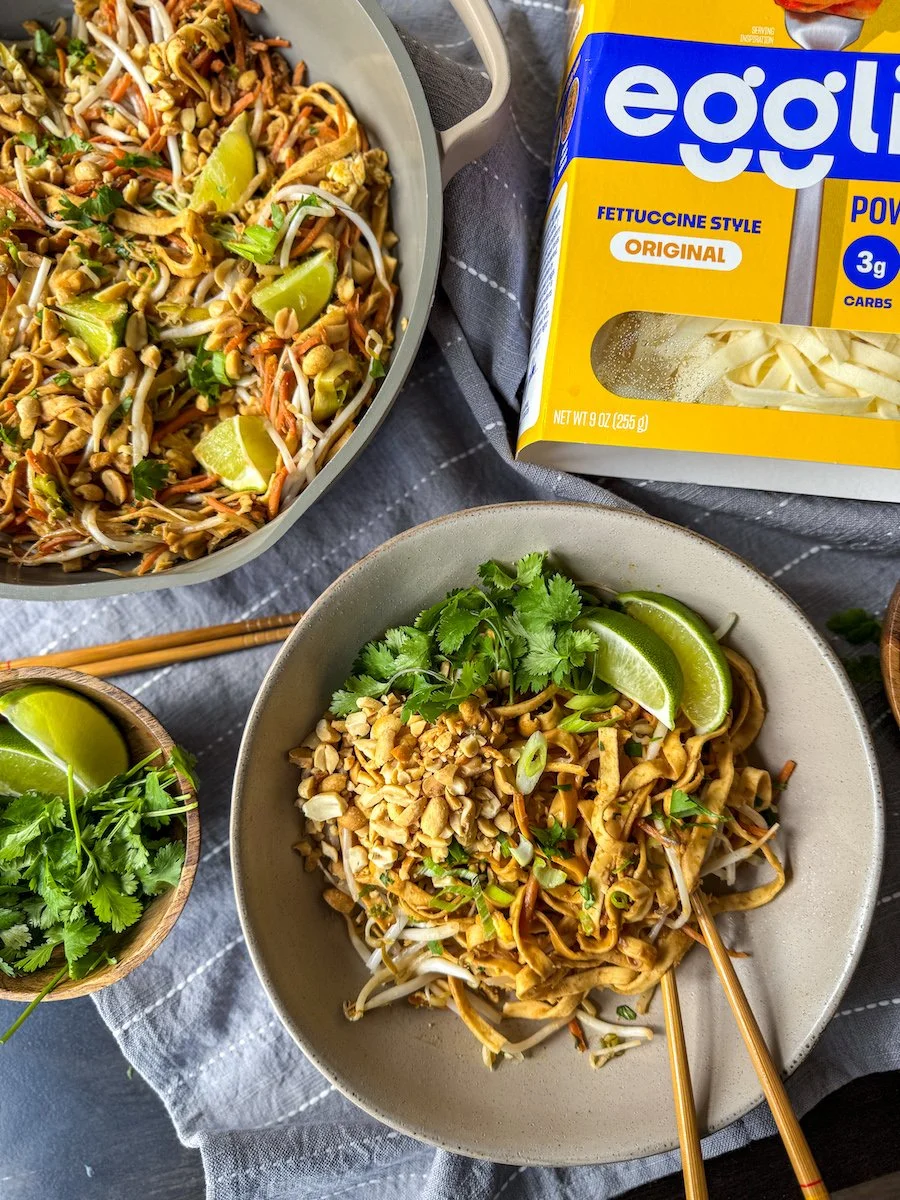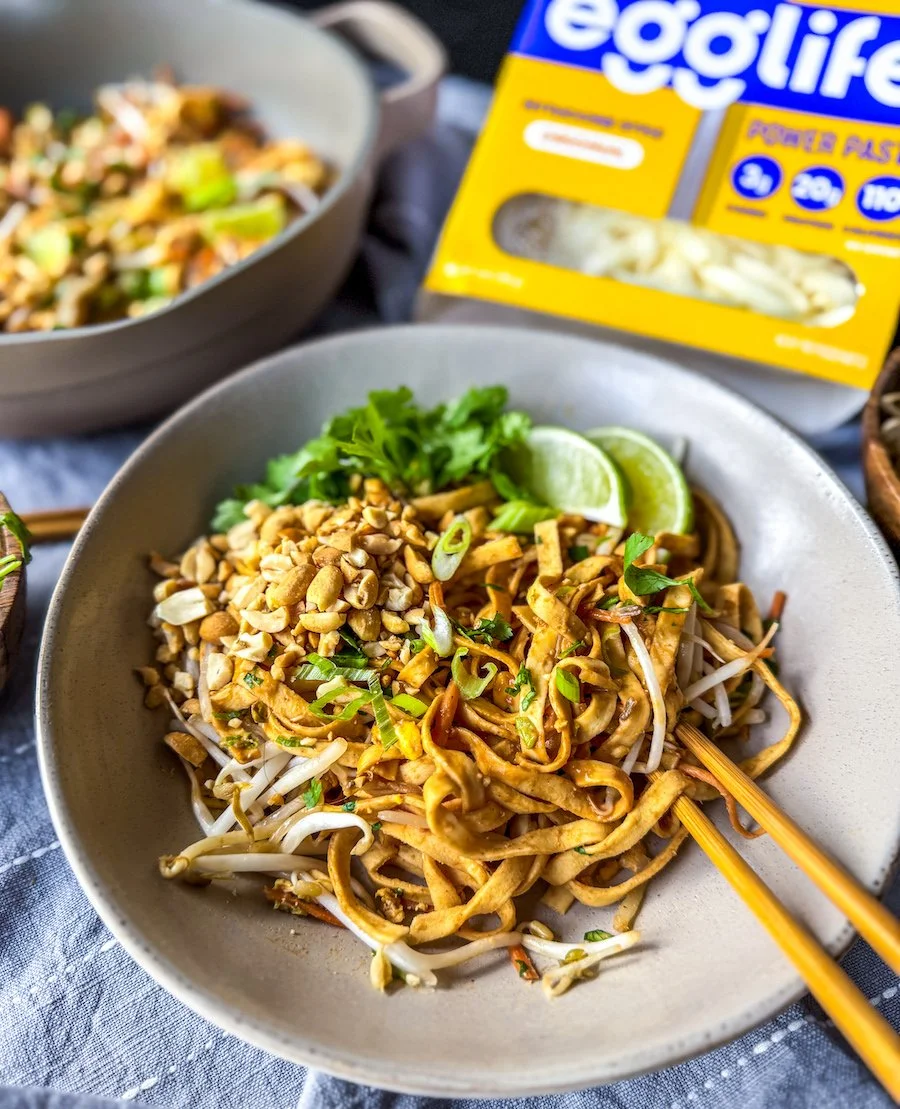High-Protein Pad Thai Recipe with egglife Power Pasta
Makes: 3 Servings
Per Serving: 38g Protein | 371 Cal
Listen, I love me a good asian noodle take out dish….ugh, my absolute favorite! BUT, ordering takeout noodles for dinner multiple times a week is probably not the greatest choice for my health. That’s why when egglife dropped their brand new POWER PASTA — pasta that is made from EGGS not flour, I jumped at the chance to make one of my favorite takeout noodle dishes —- PAD THAI!
My high-protein, low-carb Pad Thai is packed with tons of fresh flavors, loaded with tons of colorful veggies, and is ready in under 15 minutes. IT IS SO EASY TO MAKE, PEOPLE!
Each serving of this delicious, savory-sweet, peanuty Pad Thai contains 38 grams of protein and only 24 grams of carbs and is super customizable based on your preferences! Want to add more veggies? Go for it! Want to use real peanut butter? Sure!
This dish is about to become your weeknight staple. Just you wait and see!
Why You’ll Love This Healthy, High-Protein Pad Thai Recipe
Ready in about 15 minutes: This quick and easy meal comes together in about 15 minutes, which means making it is even faster than ordering takeout.
Great macros: If you’re counting macros, this meal is a total winner. It’s low in carbs and high in protein, perfect for fueling your body after a workout or eating a healthy and balanced meal.
Versatile and easy to customize: Switch up the vegetables based on your favorite foods, add grilled chicken, tofu, or sautéed tiny shrimp for even more protein.
Great for meal prepping: This easy Pad Thai holds up well in the fridge for up to 3 days, making it super meal-prep friendly.
Ingredients
Veggies & Toppings:
1 tablespoon minced garlic (jarred works!)
2 cups shredded carrots
2 cups mung bean sprouts, divided
4 stalks green onion (3 thinly sliced long, 1 sliced small for garnish)
2 eggs
One package of Egglife POWER PASTA (3 cups)
A handful of cilantro, chopped
¼ cup peanuts, crushed
A couple of lime wedges, for garnish
Sauce:
½ cup powdered peanut butter (or 6 tablespoons regular peanut butter)
3 tablespoons coconut aminos
3 tablespoons rice vinegar
2 tablespoons maple syrup or agave (adjust to taste)
1 tablespoon toasted sesame oil (optional)
1 tablespoon grated fresh ginger (or ¾ teaspoon ground)
Juice of 1 lime (about 3 tablespoons)
6–12 tablespoons warm water, to thin to your desired consistency
Instructions
Make the Pad Thai sauce: In a medium bowl, add all of the sauce ingredients except for the water. Whisk until smooth and creamy. Add the warm water, 1 tablespoon at a time, until the sauce reaches the desired consistency. Set it aside until you’re ready to use it.
Prep all of the veggies and peanuts: Slice up the green onions, chop the cilantro, and crush the peanuts. You can quickly and easily crush the peanuts by placing them in a zipper-topped plastic bag, then hit them with a meat mallet or rolling pin until they’re the right size and shape.
Start cooking the veggies: Heat about 1 tablespoon of avocado oil, canola oil, or extra virgin olive oil in a large skillet over wok over medium heat. Add the minced garlic, shredded carrots, about half of the bean sprouts, and the long-sliced green onions. Sauté for about 3 minutes, until the veggies are tender, but still bright in color.
Cook the eggs: Push all of the veggies and aromatics to one side of the pan. Crack the eggs into the other side of the pan. Scramble the whole egg until cooked all the way through, then mix with the veggies.
Add the noodles: Gently separate the noodles with your fingers so they don’t clump. Add them to the skillet along with half of the sauce. Toss everything gently until it’s all well coated with sauce. Add more sauce if needed.
Finish the dish: Add the small-cut green onions, most of the cilantro, crushed peanuts (or even sunflower seeds, if you're dealing with strict allergen concerns), and the rest of the bean sprouts. Toss again and then turn off the heat.
Garnish and serve: Sprinkle with extra cilantro, additional peanuts, and serve with lime wedges on the side. Squeeze with lime juice over each serving of food before eating. Enjoy!
Nutrition Data (Per Serving - Makes 3 Servings)
Calorie Count: 371
Protein: 38g
Carbs: 24g
Fat: 15g
Swaps & Substitutions
Add more protein: If you want to up the protein even more, add chicken breast, shrimp, tofu, organic soybeans (organic edamame), or anything else you like.
Add some heat: Add a drizzle of sriracha sauce, a bit of sambal, or some crushed red pepper flakes to add a little spice.
Swap out the noodles: Can’t find Egglife’s new noodles? Use zucchini noodles, shirataki noodles, hearts of palm noodles, sweet potato noodles, or even cooked rice noodles.
Store your leftovers the right way: This recipe makes three hearty portion sizes and stores well in an airtight container in the fridge. Gently reheat the Pad Thai in a pan with a splash of water or a little extra sauce for best results.
FAQs
-
egglife’s Power Pasta is my favorite thing to use in this recipe, but if you can’t find them, you can use shirataki noodles, hearts of palm noodles, zucchini noodles, stir-fried rice noodles or spaghetti squash!
-
You sure can! Instead of the powdered peanut butter, you can use 6 tablespoons of creamy peanut butter. It’ll make the sauce richer and creamier, so make sure you use enough water to thin it to the right consistency.
-
If you don’t have any peanut butter or can’t tolerate it, you can make this sauce with almond butter, cashew butter, or even sunflower seed butter if you have food allergies. The flavor and macros will be a little bit different, but it’ll still be good. Make sure you pick one without added sugar.
-
If you want to meal prep this Pad Thai, here are a few tips to ensure you’ll get the best results:
Store the sauce and Pad Thai separately until you’re ready to reheat your portion.
Don’t add the cilantro, peanuts, and lime until you’re ready to eat.
Gently reheat your portion in a skillet with a splash of water or extra sauce for best results.
-
If you don’t have access to coconut aminos, you can use low-sodium soy sauce or tamari. Look for a certified gluten-free seal on your tamari bottle and read the ingredient labels on your other ingredients to make sure it’s safe to eat if you’re dealing with specific nutrition concerns. You can also add a dash of fish sauce and tamarind paste for more authentic flavor (make sure you don’t add too much). These sauces are super salty, so make sure you adjust the amount of salt you add to the dish so you don’t over-salt.
-
You can use shredded cabbage, zucchini, snow peas, thinly sliced bell peppers, spinach, or whatever else you love. This recipe is super versatile!
Pad Thai is so satisfying and comforting. This high-protein version is packed with tons of veggies and topped off with a sweet and savory sauce. Whether you’re looking for a quick and easy weeknight meal or are trying to remedy your takeout-ordering habit, this recipe delivers. Try it, you’re going to love it!

High-Protein Pad Thai
Ever wonder about the nutrition in Pad Thai? This high-protein, low-carb recipe made with Egglife noodles packs a big punch.
Ingredients
- 1 tablespoon minced garlic (jarred works!)
- 2 cups shredded carrots
- 2 cups mung bean sprouts, divided
- 4 stalks green onion (3 thinly sliced long, 1 sliced small for garnish)
- 2 eggs
- One package of Egglife POWER PASTA (3 cups)
- A handful of cilantro, chopped
- ¼ cup peanuts, crushed
- A couple of lime wedges, for garnish
- ½ cup powdered peanut butter (or 6 tablespoons regular peanut butter)
- 3 tablespoons coconut aminos
- 3 tablespoons rice vinegar
- 2 tablespoons maple syrup or agave (adjust to taste)
- 1 tablespoon toasted sesame oil (optional)
- 1 tablespoon grated fresh ginger (or ¾ teaspoon ground)
- Juice of 1 lime (about 3 tablespoons)
- 6–12 tablespoons warm water, to thin to your desired consistency
Instructions
- Make the Pad Thai sauce: In a medium bowl, add all of the sauce ingredients except for the water. Whisk until smooth and creamy. Add the warm water, 1 tablespoon at a time, until the sauce reaches the desired consistency. Set it aside until you’re ready to use it.
- Prep all of the veggies and peanuts: Slice up the green onions, chop the cilantro, and crush the peanuts. You can quickly and easily crush the peanuts by placing them in a zipper-topped plastic bag, then hit them with a meat mallet or rolling pin until they’re the right size and shape.
- Start cooking the veggies: Heat about 1 tablespoon of avocado oil, canola oil, or extra virgin olive oil in a large skillet over wok over medium heat. Add the minced garlic, shredded carrots, about half of the bean sprouts, and the long-sliced green onions. Sauté for about 3 minutes, until the veggies are tender, but still bright in color.
- Cook the eggs: Push all of the veggies and aromatics to one side of the pan. Crack the eggs into the other side of the pan. Scramble the whole egg until cooked all the way through, then mix with the veggies.
- Add the noodles: Gently separate the noodles with your fingers so they don’t clump. Add them to the skillet along with half of the sauce. Toss everything gently until it’s all well coated with sauce. Add more sauce if needed.
- Finish the dish: Add the small-cut green onions, most of the cilantro, crushed peanuts (or even sunflower seeds, if you're dealing with strict allergen concerns), and the rest of the bean sprouts. Toss again and then turn off the heat.
- Garnish and serve: Sprinkle with extra cilantro, additional peanuts, and serve with lime wedges on the side. Squeeze with lime juice over each serving of food before eating. Enjoy!
Nutrition Facts
Calories
371Fat
15 gCarbs
24 gProtein
38 gNutrition info is based off of estimates. They are calculated by taking the ingredients in this recipe and dividing them by the number of servings.





